Cushing’s Disease; I’ve had a brain tumour the whole time
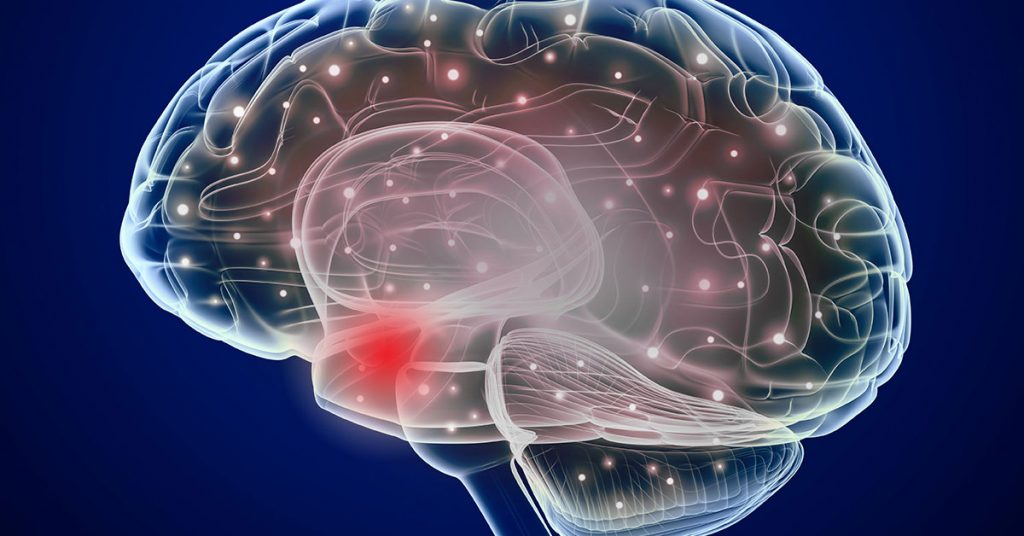
What is Cushing’s?
Cushing’s Disease
- ACTH-secreting tumour (adenoma)
- Tumour is usually on the pituitary gland at the base of the brain
- ACTH (adrenocorticotropin) tells the adrenal glands on top of the kidneys to produce too much cortisol
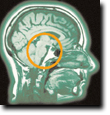

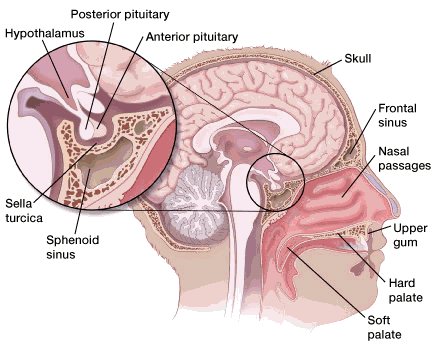
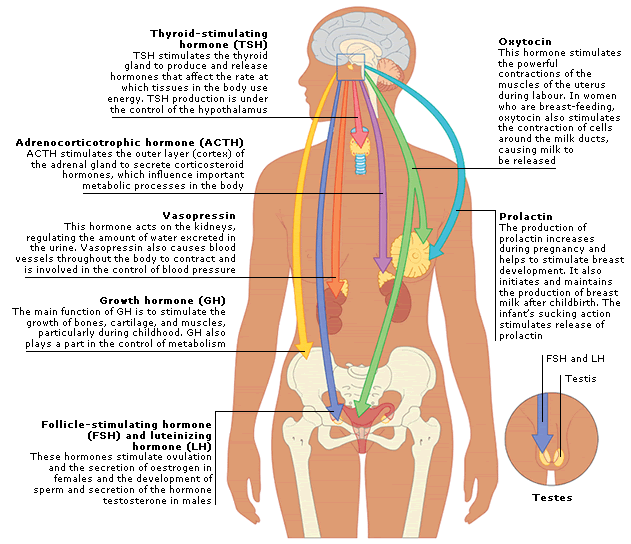
Cushing’s Syndrome
- Tumour on one of the adrenal glands causing the release of too much cortisol
- Ectopic ACTH production from a tumour elsewhere, in turn causing the adrenal glands to release too much cortisol
- Familial Cushing’s; rarely, Cushing’s can be passed on by way of an inherited tendency to develop tumours on endocrine glands
- Exogenous Cushing’s, caused by taking corticosteroid medication
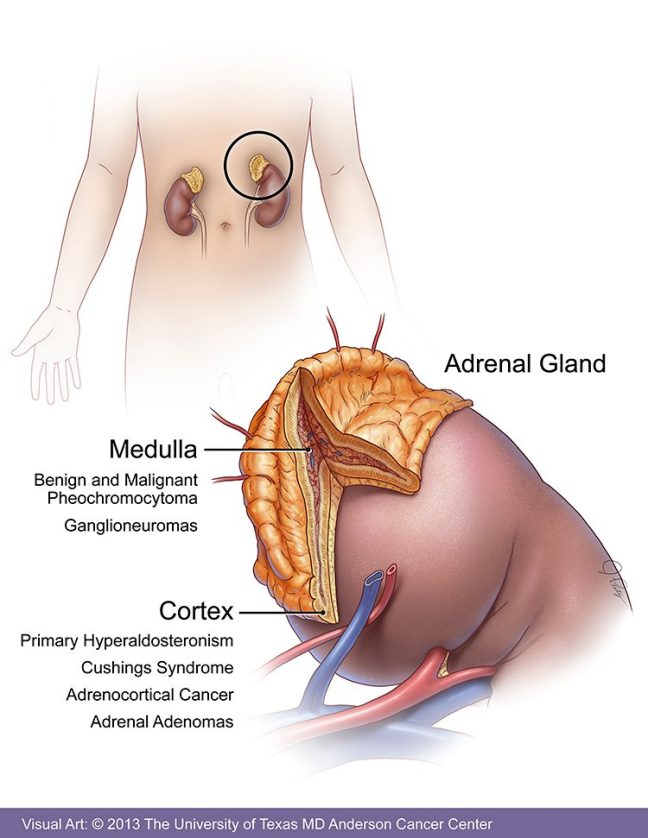
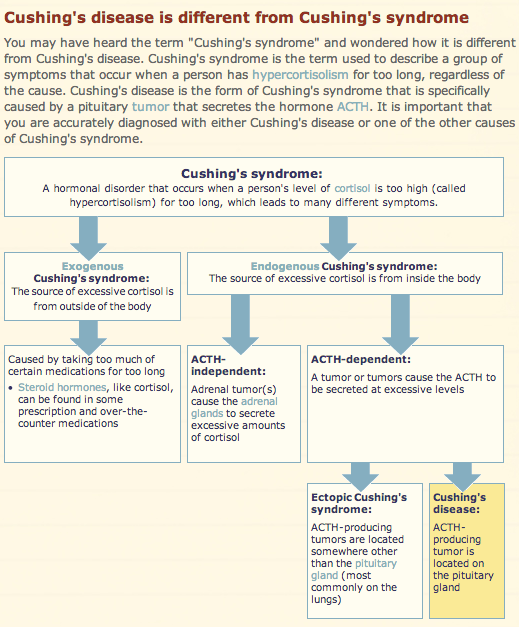
Cushing’s Disease and Syndrome are named after Harvey Cushing, an American neurosurgeon who was the first person to describe Cushing’s Disease, in 1912.
CUSHING’S IS FATAL. If you think you may have Cushing’s, you must have it investigated.
What is Cortisol?
Cortisol is commonly referred to as “the stress hormone.” It does a lot of essential things throughout the body, including allowing us to respond to stress. But too much of it can cause absolutely hideous symptoms (as can too little of it, the opposite problem, Addison’s Disease or Adrenal Insufficiency).
I discovered Cushing’s completely by accident. I was browsing homeware on Pinterest, as I often do for fun. In one of the related images to something I was looking at, was a silhouette of a body like mine. In fact, I was astounded by how much it looked like me, and how many of the symptoms listed next to it I had. I wrote to my GP, who in turn wrote to the endocrinologist.
I’m going to talk about some of the symptoms that are indicative of Cushing’s Disease or Syndrome, and my experience with them. Please note that this is far from an exhaustive list, both in terms of my experiences and symptoms that can indicate Cushing’s, there are just too many minutiae to go into.
For example, I was diagnosed with both cubital tunnel and carpal tunnel syndrome after numbness brought on by trapping my ulnar nerve; I’ve noticed in Cushing’s patients’ stories that there is a correlation here, with many of them developing either or both of these syndromes in one or both arms, even though I’m not sure how Cushing’s could be causative of this!
Also, it is possible to be an atypical Cushing’s case, so don’t ignore some symptoms because you don’t have all the others. I watched a webinar that mentioned the case of a woman who looked slim and normal aside from some pigmentation on her face, it turned out she had a pituitary tumour and it was completely unexpected.

After discovering Cushing’s Disease, I did a lot of research. I don’t mean “research” like people on the internet normally mean. I ordered ten years of medical records and started looking through them for all the things that pointed to this. I read papers I could access, I watched webinars and lectures, and I watched a lot of videos of patient stories. So many of them seemed to be describing my life story. A lot of them mentioned things that aren’t covered by the literature but seem to be regular experiences anyway. So with that, here’s my Cushing’s story.
Weight gain
I can pinpoint the end of 2010 as the time I suddenly started gaining weight. Will and I moved in together and it kind of just started happening. I was always aware that I didn’t look like other fat people. I didn’t proportionally gain inches across my body, I didn’t have fat calves or ankles or wrists. Overwhelmingly, the fat sprouted in my neck, face, abdomen, upper body. My legs always looked a bit bizarre under my giant abdomen.
My joint pain started getting a lot worse around this time. In 2011 I had to start using a walking stick and a wheelchair. I had always known this was a possibility, as I was born with an inherited connective tissue disease called Ehlers-Danlos Syndrome. In short, this is an abnormality in the production of collagen in the body. This means that places like cartilage, bones, tendons, ligaments, skin, and the walls of blood vessels and organs are affected. Joints can easily dislocate because tissues stretch too far, vessels and skin can easily split, etc. Because of this, I thought it was normal that my pain increased, and that my weight increased because I was moving less because of my genetic condition becoming more symptomatic with age.
In hindsight, I know that the weight gain was caused by Cushing’s Disease, and that if this had been spotted sooner, increased strain on my already fragile body could have been avoided, and I could have avoided needing a wheelchair to travel any sort of distance, as many people with EDS do get by without one.
I am only 4’11” in height so weight gain was always particularly visible on me. I did always tell my doctors that I simply was not eating enough to sustain so much weight gain, but eventually I was convinced that I was in denial.
And sometimes over the past 10 years, I definitely have eaten too much. I developed Binge Eating Disorder to try and cope with constant stress. But I still struggled to see how I could be so gigantically round from the calories I was consuming.
A few years ago, I starved myself by existing on mug soup. It was miserable, and after a few months, I actually saw some weight loss. But it was very temporary, and other Cushing’s patients report the same thing. You can only lose small amounts of weight for short amounts of time, and it’s so hard. The endocrine system has been absolutely pummelled.



“Buffalo hump”
This is a pad of fat at the base of the neck, between the shoulder blades. I assumed this was part of being obese, but it’s actually indicative of Cushing’s Disease. Alarmingly, I can spot this developing on myself in old photos going back before 2010.
Like this dorsocervical fat pad, supraclavicular fat pads (pads over the collarbones) are also symptoms of Cushing’s. Even when I was thin before I was ill, it was usually impossible to see my collarbones.
Severe Hirsutism
For a long time I have been growing a facial beard that needs daily shaving. It has gotten worse over time and even immediately after a close shave there are visible dark roots in my skin. I grow black hairs on my chest, breasts, abdomen, and the “buffalo hump” at the back of my neck.
I have previously attributed this symptom to PCOS as I have ovarian cysts and other women in my family have received this diagnosis too. However, apparently half of women with Cushing’s also have ovarian cysts.
Male-pattern hair loss
My hairline has been quite badly receding, especially over my temples. I also lose a lot of hair when I comb or brush it. The paper “Skin manifestations of Cushing’s Syndrome” (PMID: 27943005) notes “temporal scalp hair regression” as a symptom.
Blood sugar
I have had insulin resistance for a long time. My diagnosis was Type 2 Diabetes with hypoglycaemia. However, my doctors later came to doubt that diagnosis as it didn’t entirely match up. I haven’t been rediagnosed with anything different, it’s just an ambiguous state of affairs.
I really suffered when I was first becoming diabetic. Hypoglycaemia was out of control for a few years and I almost died from an attack in my sleep. This was all brought about by increased cortisol caused by the tumour.
Apparently 1 in 20 patients with Type 2 Diabetes have endogenous Cushing’s.
Skin & Pigmentation
For a long time I’ve had what has been considered Rosacea, an autoimmune disease of the skin. I still think it’s possible I may have independently had rosacea, as I mainly experience redness resembling subtype 1, but I experienced painful “outbreaks” resembling subtype 2 periodically.
Much of the redness could have actually been down to a tumour. Cushing’s causes facial redness and weird skin pigmentation. I have had paler areas around my eyes that I refer to as “reverse panda eyes” and they include white streaks going down my cheeks at the outer edge of the eyes. I still haven’t discovered a proper term for these but I’ve spotted them on photos of other Cushing’s patients, such as this woman below.

It was around October 2019 that I first noticed parts of my face staying brown when I wasn’t tanned. I have very pale skin but I do tan because I’m multiracial. I wasn’t tanned in October though, and I noticed in a photo that my husband took of me when we got back from our 1st wedding anniversary dinner, I had a big circle of brown pigment on my face, which notably ended around my hairline and eyes. I didn’t have any makeup on except for pink eyeshadow.

Sometimes this area of skin is a much darker brown, and sometimes it is a paler red, but it has never entirely gone away.
Sometimes I developed random brown pigment patches on other areas of my body. There is one on my arm that I thought was a bruise, but it stayed forever. There are 2 on my abdomen, and maybe others I can’t see. These may disappear after surgery.
Something that I don’t talk about very often is Hidradenitis Suppurativa. In short, hair follicles on my body are prone to becoming blocked and infected. This causes extremely painful cysts that are sometimes just filled with blood. There seems to be a lot of overlap with Cushing’s and Hidradenitis.
I sometimes go through periods where I just have loads of acne and I don’t know why.
I also have a lot of marks that I now know are called Acanthosis nigricans. As well as being browner in the creases of my body (see Google for examples), I also realised that my finger knuckles and a line of skin above each of my nails is browner or redder than the rest of my skin. This is something that I never realised was abnormal because I never spent a great deal of time staring at other people’s hands.
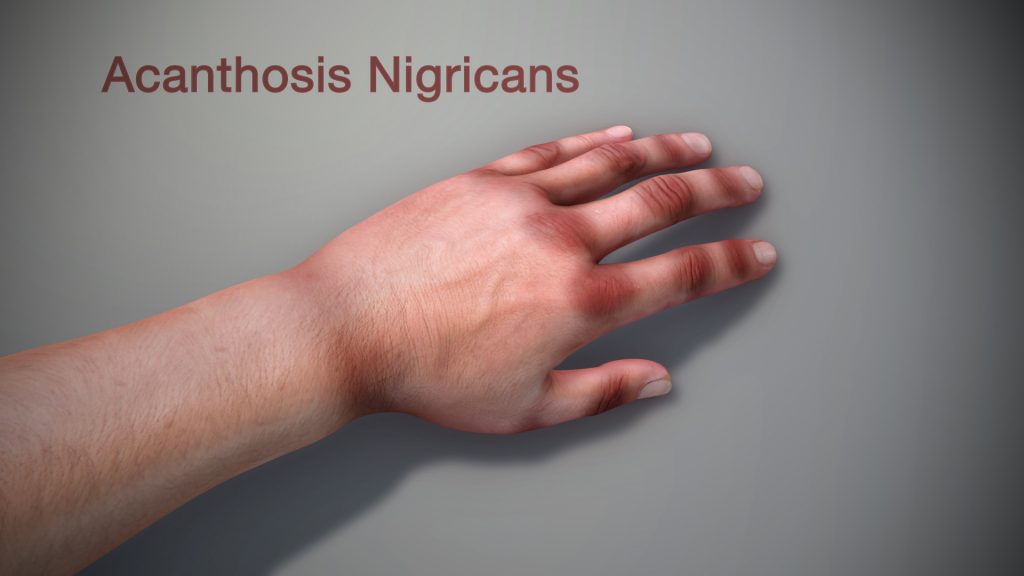
My skin is easily bruised and torn, which is a Cushing’s symptom. However, this is also a symptom of my connective tissue disease, so it is likely I would experience this anyway.
Parts of my skin on my arms are very thin and I don’t like touching those areas because it’s squicky.
Red and purple stretch marks are another symptom of Cushing’s. I had always assumed that marks like this were from skin tearing and atrophic scarring from my connective tissue disease, but because these marks can be very dark when new they were likely also another manifestation of Cushing’s.


Nails
I noticed one day that I had brown stripes and marks down some of my nails. They were not the usual dark flecks caused by bleeding in the nail bed (splinter haemorrhages), and were more of a latte colour. I found out that these are called Melanonychia.
Apparently Melanonychia occurs in many Afro-Caribbean people and around 20% of Japanese people, but I didn’t think that would be a reason for me to suddenly have these nail marks. Sure enough, Melanonychia can be caused by endocrine disorders such as Cushing’s Disease.
I also have Mees’ Lines, and Terry’s Nails causing the lighter half of my fingernails to point down into the darker half like a triangle. My thumbnails, however, do have lunula.
There is also a thin brown border above the free edge of my nail. Once again, I failed to realise this wasn’t normal because I haven’t been staring at other people’s hands.
These symptoms indicate liver and kidney problems as caused by Cushing’s.
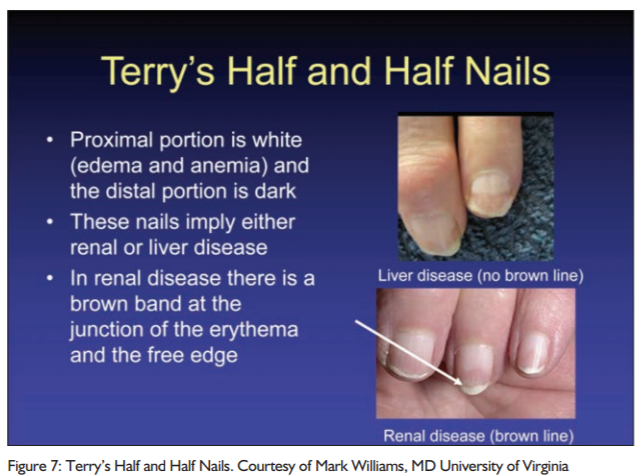
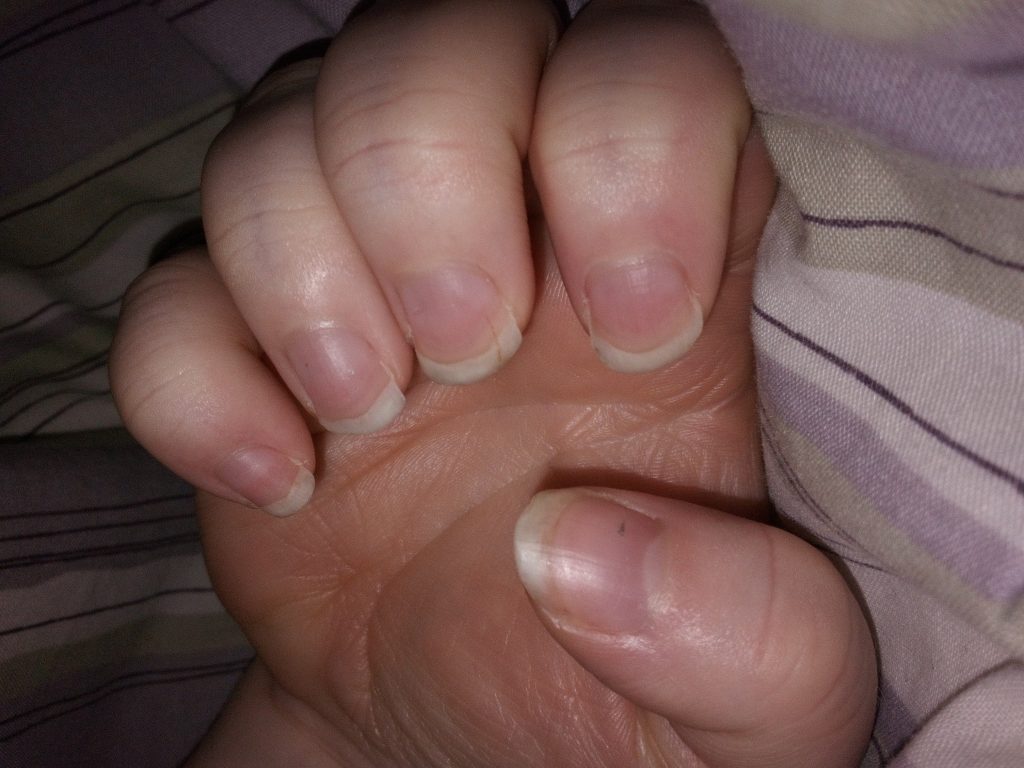
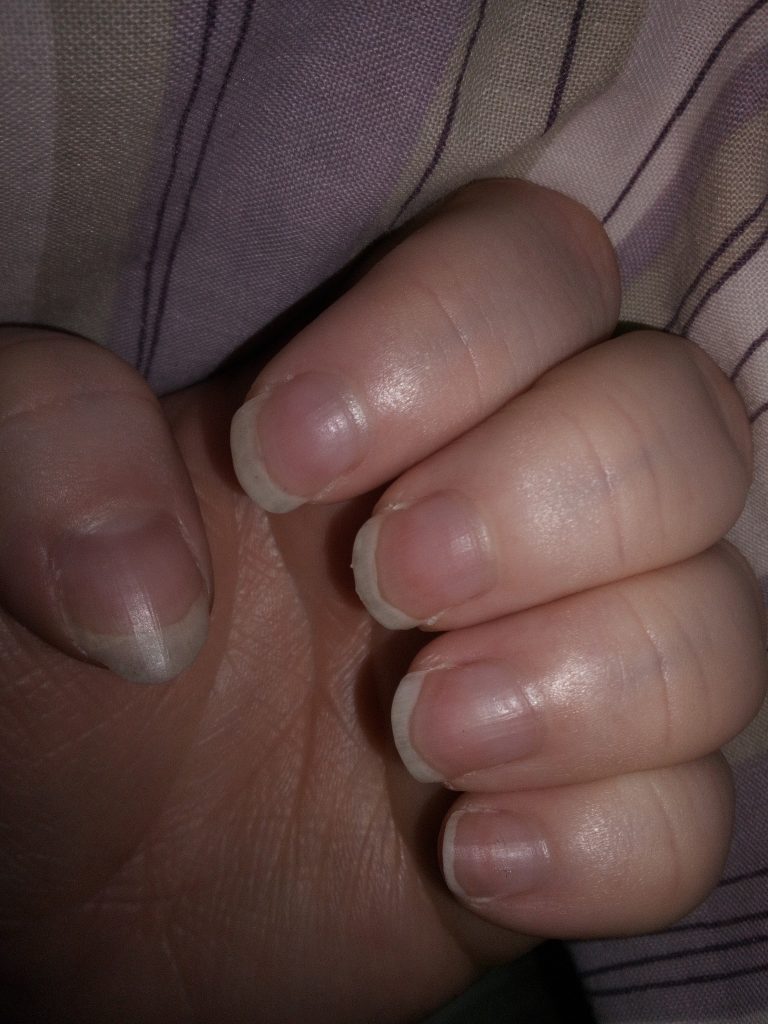
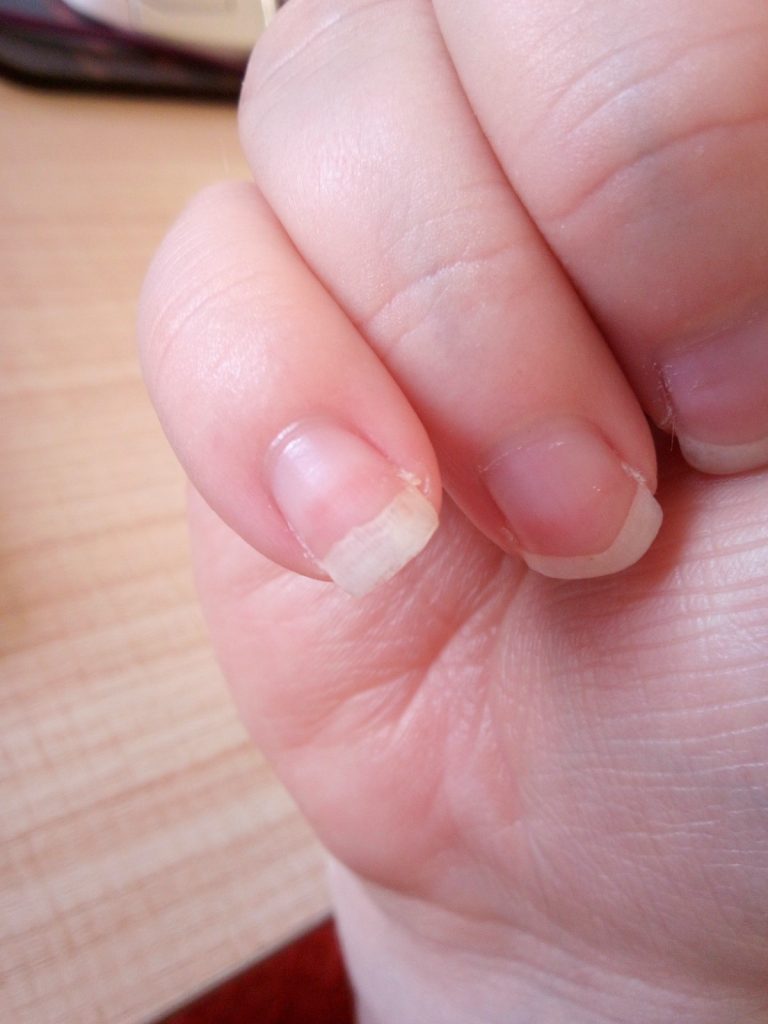

Mental health problems
This is a difficult one as it makes me wonder how long the tumour has been there causing problems. It’s at least 10 years, but it could even be 20. There are things that happened that I know it was reasonable to develop mental health problems in response to. But they might not have needed to be quite so severe, or maybe some things just wouldn’t have happened if it weren’t for the tumour leading me there. It’s made me second-guess my whole life.
I had severe depression for a long time but this past year I realised my symptoms had been more in line with Bipolar disorder all along. The same symptoms as Bipolar are known to be caused by pituitary adenomas.
I have also had episodes of psychosis with severe hallucinations. Those were pretty miserable times.
Stress levels
For as long as I can remember I have been extremely anxious and hypervigilant. Even when I am supposedly relaxing, I am having a million thoughts. Every little thing is an enormous problem and I am prone to what my husband describes as “bridge-burning reactions.” And it all makes sense now, because my blood has been absolutely swimming in cortisol.
Cognitive function and headaches
For a few years now I have been experiencing what has been diagnosed as Chronic Daily Migraine (migraines on 15 or more days per month). Triptans are largely ineffective and make me feel ill, whereas Botox injections provide some relief for a short time.
Prior to this I would get one or two migraines a year. It was approximately around the end of 2016 when I suddenly started having debilitating migraines for at least a couple of hours almost every day. This was also a time when my highest ever weight went further up and the pituitary adenoma was clearly getting worse.
I often feel mentally unwell and never quite present, and I know that the way I feel everyday in my head is not a normal way to feel.
I feel like I just got so much worse in 2020, like I’m reaching the end stages of what can possibly happen to me. There are times when I cannot tell the difference between dreams and reality. I could absolutely swear that a conversation or event happened, but nobody else will remember it. Likewise, the reverse can happen, I can be so absolutely certain that I dreamt something, only for someone else to bring it up later. I feel like I have no idea what’s going on half the time.
The last 10+ years of my life have been a complete whirlwind of blurry chaos and the only things I can feel certain about are events I have photos of.
Something that worries me a lot about Cushing’s is the “personality changes” and “behavioural disturbances” the tumour causes. Especially considering how long the tumour could have been there.
How deep do these personality changes go? And what are mine? If I have successful surgery to remove the tumour, how much will I change?
Will I like the same things? Will I still be in love with my husband? Will my husband still love me? It’s terrifying. What if I just wake up and I don’t care about dogs or games or Halloween?
Menstruation, infertility, and libido
I can’t pinpoint when I first started having menstrual irregularities, as at the time that a lot of other Cushing’s symptoms started I had a Mirena IUS in to curb another condition. I didn’t have periods while this was installed. After I had it taken out a few years later, I noticed that my periods were irregular with no predictable pattern. I could be caught out by them coming on completely suddenly out of nothing, and the first couple of days were often so bad that I would need incontinence pads to prevent bleeding through my clothes.
Recently, I’ve had no menstrual periods at all. I don’t think I had one at all during 2019 and I definitely didn’t have one during 2020.
I’m currently infertile by virtue of the fact that I am not building up a uterine lining for an egg to be implanted into, and am likely not ovulating. Things like this should go back to normal after Cushing’s surgery.
Before all this happened I had a pretty high sex drive, but now I go through phases where I don’t have a single sexual thought for a while. I must stress that this is not because of my husband in any way, I just genuinely forget that sex exists.
Sleep problems
I’m not really sure where to start with this, but sleep irregularities have plagued me for some time. I go through phases where, no matter how tired I am, I just become absolutely wired at 10 or 11 at night and I have to get out of bed because I am not going to fall asleep any time soon. Unfortunately I was stuck in this phase for the majority of 2020 and I spent surprisingly few nights asleep next to my husband. It’s a strange form of torture, existing in a separate timezone to the rest of your household.
If I can get to sleep before midnight, then it is usually bang on 2am that I will suddenly be full of life, and I’ll be stuck awake until about 6am. This is a nightmare if I have somewhere to be. I’ve often wished there was some sort of sedative pen we could inject ourselves with for some blissful unconsciousness at a ridiculous hour.
A doctor recommended an OTC sleeping pill to me and unfortunately these only worked about twice, I became impervious to them after that and no matter how drowsy or otherwise fatigued I was, I just felt like my body was too awake.
This is probably the worst part of Cushing’s after the extreme weight gain, it is soul-destroying.
Severe fatigue
I have a diagnosis of Chronic Fatigue and this is another thing that could be explained by Cushing’s Disease. I experience what I refer to as “fatigue attacks” where I am suddenly so tired that I need to go and lie down even if I am not sleepy. My brain might be awake but my muscles are switching off. I generally lack strength and energy in everything I do, for example I cannot scrub myself hard enough in the shower and I need my husband to do that.
Vertigo and dizziness
In extremely simplified terms, vertigo can be the feeling of the environment spinning around you, whereas dizziness can be the feeling that you specifically are spinning or going over.
Unfortunately I experience both. The latter can be put down to Dysautonomia, which I have secondary to Ehlers-Danlos (although I am unsure whether Cushing’s could itself cause Dysautonomia), but vertigo is a separate symptom which could indicate Cushing’s.
Hearing loss
A few years ago I started losing my hearing. I had long had problems with auditory processing but was able to hear the sound in the first place, until around 2015 when I stopped being able to hear most background sounds and had difficulty hearing people talking to me. I now need hearing aids when talking to someone I do not know well. PMID: 28553606 mentions that pituitary adenomas can be a cause of such hearing loss.
Visual problems
I’ve been wearing glasses and contact lenses for a long time, but lately I’ve noticed that while my prescription has not changed per se, my vision in general is getting blurrier and I’ve lost the ability to see fine detail. This can be due to the pituitary adenoma putting pressure on the optic nerve.
Frequent infections
For some reason I am extremely regularly subject to all sorts of infections. These include regular ear infections even if I have not needed to put my hearing aids in, frequent bladder and urinary tract infections (I seem to have one every other month), when my wisdom teeth erupted I instantly had pericoronitis, Hidradenitis cysts are regularly subject to painful infections, regular hair follicle infections, etc.
Frequent urination
Honestly, I’m lucky if I can sit down for half an hour without peeing. Normally people tend to go to the toilet around once every two hours when awake. I could probably go every 15 minutes without any effort. If I am actually in bed at night, it’s common for me to wake up and go to the toilet. If I do manage to sleep through the night for some reason (e.g. out of it from migraine, drowsy-affect pill), my God, do I have a full bladder in the morning. I do not drink an excessive amount.
I have learned to sit on things for a while if I need to, e.g. on a road trip or at an appointment. But I have my limits and I know that if a toilet is there, I am going to let myself use it, even if it’s the billionth time I’ve got up and I’m exhausted.
Once, I was told by one of my consultants to drink 3 litres of water when I woke up in the morning, to help with a form of Dysautonomia. This didn’t last long because it was making me spend my entire life on the toilet.
Diabetes Insipidus is common after pituitary surgery (see information below), but it is possible to have it beforehand with Cushing’s, if the tumour is pressing on the back of the gland and causing a shortage of Vasopressin.
Somewhere I differ from most Cushing’s patients
Most of the time I have low-normal or below normal blood pressure, because I have Ehlers-Danlos and Dysautonomia, in contrast to high blood pressure as a Cushing’s symptom. If I did not have a different disease affecting the autonomic nervous system, I may well have had high blood pressure instead.
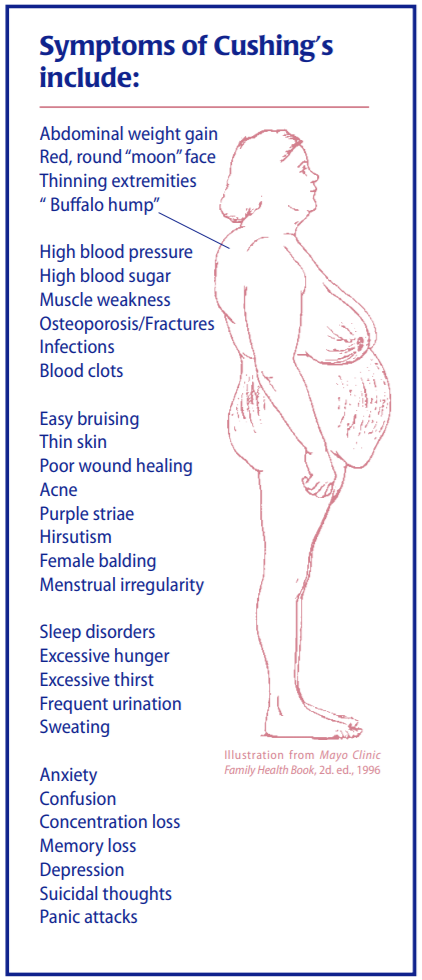
How is Cushing’s treated?
This depends on your cause of hypercortisolism. In 70% of cases this will be a pituitary tumour, so you will need to have this removed.
Thankfully, you will most likely not need to have your skull sawn-open for this. I’m not sure I could deal with that.
Because the pituitary gland is on the bottom of the brain, it can be reached through something called Transsphenoidal Surgery. In short, this involves going up through your nose.

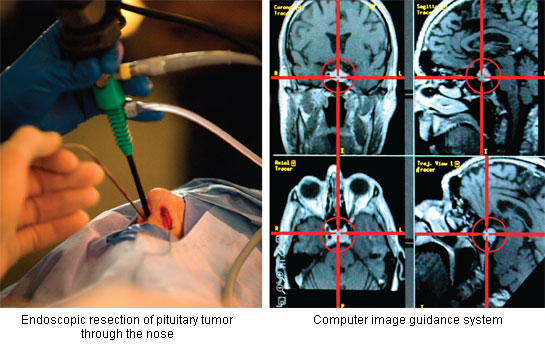
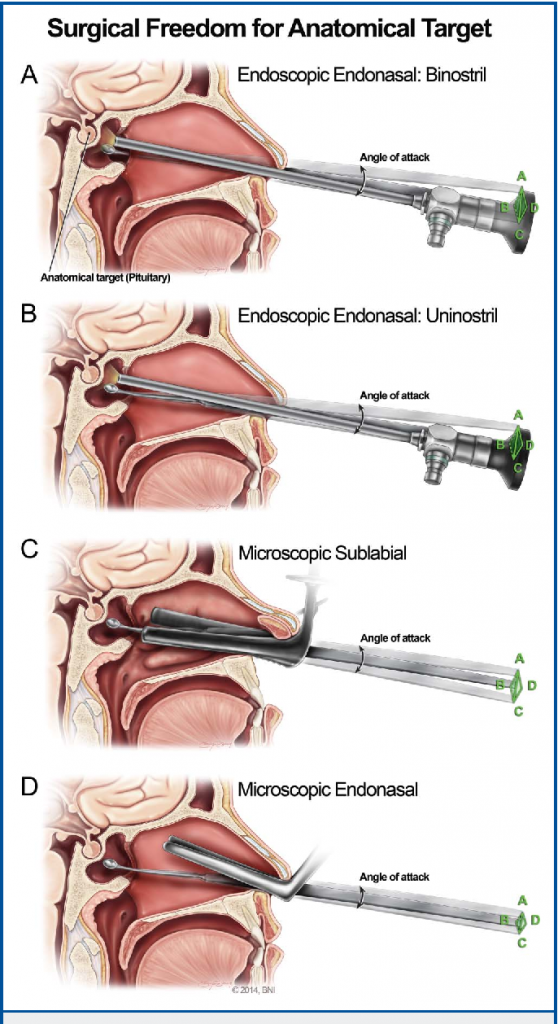
I looked up a video of surgeons going through the sellar floor to get to the pituitary a while ago; I don’t advise doing this unless you’re fairly certain you’ll be OK with it because I literally fainted. Thankfully I was sitting on the floor with my back against the base of the sofa so there wasn’t far for me to go but I felt unwell for a while!
There are a lot of variables in patient situations and sometimes transsphenoidal surgery won’t work. It is also possible to have Transcranial pituitary surgery (opening the skull and retracting the front of the brain), Transglabellar (through the forehead), etc. although I think these would be unusual.
After removing a pituitary tumour, you are likely to have Adrenal Insufficiency (secondary to Cushing’s, primary adrenal insufficiency would be Addison’s Disease).
Because the tumour will not be producing so much ACTH, the adrenal glands will stop producing cortisol. This is good in that it will resolve the symptoms of Cushing’s, but unfortunately we do need some cortisol to live, so you will be steroid dependant for a while if this happens. For a lot of people the adrenal glands do wake up again and start producing cortisol normally.
It is also possible to develop Diabetes Insipidus after pituitary surgery. Damage to neurons secreting Vasopressin means that your body will not regulate urine output properly and will squeeze out every last drop of moisture when you do not have it to give. This may not be permanent, but you will be dependent on Desmopressin for at least a while.
If the tumour is in one of the adrenal glands, then that gland will need to be removed. If it is in another organ it will need to be found and removed.
If a tumour cannot be completely removed, recurs, or doesn’t respond to other available avenues like radiotherapy, the adrenal glands may need to be removed so that they cannot keep pumping out cortisol in response to the ACTH production in the body. This will mean that you are permanently steroid-dependent, but you also won’t die from Cushing’s.
Conclusion
Cushing’s Disease and Syndrome are horrible and more people need to know about them. I hope this post can save somebody who is now able to connect the dots.
Unfortunately you may have to fight for your diagnosis. Most doctors do not specialise in things like Cushing’s and even an endocrinologist will not expect to see it. Some patients go through “cycles” where they temporarily produce less cortisol and this will make them fail testing. Multiple rounds of testing may be required, which is not only exhausting for patients but frustrating for doctors.
My website in general is not about Cushing’s, it’s just thoughts about random things in my life (and everything prior to this year is likely severely Cushing’s-addled thoughts, anyway!) so sorry if you came here just for this.
Here are some other links I recommend you look at:
- The Pituitary Foundation (UK)
- Addison’s Self-Help Group
- Cushing’s with Moxie blog
- Cushing’s Support & Research Foundation